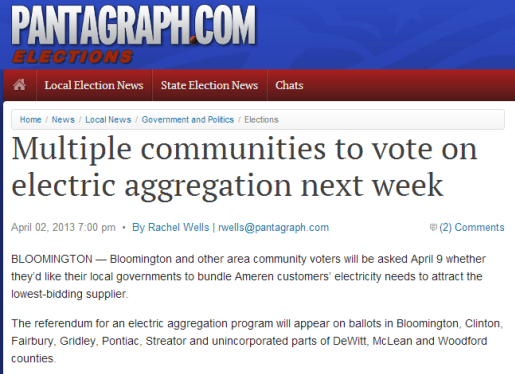Multiple Communities to Vote on Electric Aggregation April 9th, 2013
 The Committee for Municipal Electricity Choice | Posted on
The Committee for Municipal Electricity Choice | Posted on  Thursday, April 4, 2013 at 09:07AM
Thursday, April 4, 2013 at 09:07AM On April 9, voters will have the option to approve a measure in many communities in central and southern Illinois relating to electric aggregation. Should these voters approve their respective measures, they are expected to see some significant savings.
Bloomington, Clinton, Fairbury, Gridley, Pontiac, Streator, and unincorporated parts of DeWitt, McLean, and Woodford counties are all local municipalities putting aggregation to the test. Residents of Normal and Bloomington Normal rejected an aggregation measure early last year, when aggregation had just begun to take hold in the area. In November, Normal voters took a second look at the referendum and easily passed it, creating almost immediate savings for all residents.
Normal voters are enjoying the benefits of aggregation every month on their significantly reduced electric bills. Through aggregation, Normal secured a guaranteed $0.0409 per kilowatt hour rate until June, 2014. By contrast, Ameren is offering electricity for $0.054 per kilowatt hour. The Normal rate not only falls below the Ameren rate, it also guarantees their rate will not go up in June when Ameren’s rates are expected to adjust for the summer. These significant savings are not lost on the residents of surrounding communities, who are starting to wonder why they are not seeing the same savings.
Good Energy, an experienced electric aggregation consulting firm, has been contracted by nearly every municipality with an aggregation vote next week to help with the aggregation process. They have become the premier consulting firm for aggregation in Illinois, by saving money for nearly a half of a million customers in Illinois in the last 12 months. Good Energy CEO Maximilian Hoover is excited about April’s vote, hoping to help the communities voting on April 9th save on their electric bill in the same way. He says it would be wonderful to know he has helped so many customers through Good Energy.
If you would like more information about Municipal aggregation, click here. For the full article, see below.

